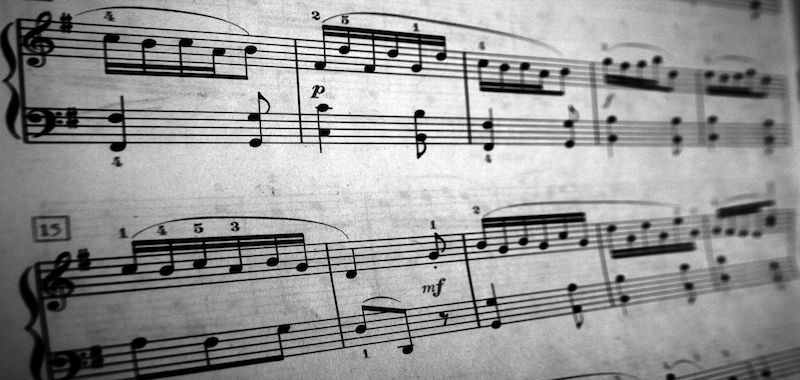5 German Arias for Mezzo You Probably Don't Know About
Where’s the Love?
What do composers have against Mezzos anyway? Is it their full and luscious middle register, their robust and powerful low notes, or their dramatic and intense top that drives composers away from the warm, welcoming arms of mezzo voices to their soprano counterparts? Some say it is because of the characters types associated with mezzos. Others attribute it to the relative rarity of the mezzo voice. No matter the reason, the mezzo predicament remains: so many auditions, so few arias. While there are some composers who give a proper nod to the sultriest of women’s voices, such as Rossini and Handel, most well-known composers composed only a few operas feautring the mezzo voice. Bizet’s Carmen, Saint-Saëns's Samson et Dalila, and Massenet’s Werther come to mind. Most of these operas are considered their most successful. Does anyone else see a trend here?
Where are the German arias?
If the lack of mezzo arias is a problem in some languages, it is an outright crisis in German. Can you sing Strauss's Composer aria? I hope so, because that is about the extent of your options. Of course I’m kidding... mostly. There are some options out there, but few of them are great. Orlofsky’s aria from Fledermaus is ok, although repetitive and lacking in, well, everything. There is also the Witch’s aria from Hansel und Gretel, which is a great moment in the opera, but a character piece is not always ideal for a young mezzo trying to show off her stuff. Character roles, such as the Witch, have very specific voice and build expectations, so much so that the character mezzo is considered by some to be a fach in and of itself, one which very few young mezzos fit into. Mezzos have the same problem with the German repertoire that all voice types do; most of it is too heavy. Wagner and Strauss are wonderful composers, but most mezzos in their mid to late twenties should not sing Erde or Klytaemnestra, yet. Even if they are able to, it can be diffictult to convince an audition panel that that is the case. When auditioning, not only are you showing your voice, you are showing the panel what fach you identify as. If you bring repertoire the adjudicators think is too big for you, even if you can sing it well, they might assume that you having a big ego or do not know your fach and/or the fach of the role.
What is the solution?
One thing is certain, you will have to go off the beaten path. If there were great arias in German that everyone knew about, there would be no reason for this article. Fear not my mezzo sisters, there are arias out there if you know where to look. I traveled into the wilderness, commonly referred to as IMSLP, and have brought back some treasures. Without further ado, here are five German arias for mezzo you probably didn’t know about.
Click on the arias' titles to see the corresponding sheet music. You can also find a link to the sheet music for all the arias listed under each aria's "Helpful Links" section.
1. “O neu Gefühl, was mich beseelet ... O Welt so schön und blühend” from Jessonda by Louis Spohr
Recitative begins at 31:49
The Run Down:
- Includes recitative: Yes
- Run time with recitative: 3:10
- Run time without recitative: 2:50
- Range: C♯4 - G5
- Tessitura: F4 - D4
- What it shows: Legato and line, minimal coloratura, middle voice.
- What it doesn’t show: High notes, acting.
- Pianist difficulty: Medium/easy.
Links:
- Sheet Music
- Louis Spohr Wiki, IMSLP
- Jessonda Wiki, IMSLP
- Spotify Recording
Louis Spohr is often referred to as “The Forgotten Master” both in books and recordings dedicated to him. While best known for his orchestral works, he also wrote over a dozen operas. This aria from Jessonda is, in many ways, a perfect audition offering. It has a very short recitative section before the aria which contains an allegro and a poco piu allegro section. Depending on how quickly you get through the recitative and how quickly you take the tempi, the whole aria takes around three minutes. The aria is pretty and gives you ample opportunity to show line and legato. There are also some small examples of more florid writing to show agility. For better or worse, this aria is fairly limited in range: C♯ 4 to G5. It also has a very manageable tessitura of F4 to D5. This aria would be ideal for younger singers and mezzos who prefer to stay on the bottom half of the staff. It could also be a good warm up aria.
If you look into this aria, you will find the role is listed as Soprano both in the scores on IMSLP and in the Wikipedia article. "Wait a second, you said these were mezzo arias!" Let me explain. At the time Jessonda was written, the delineation between sopranos and mezzos was not often made. The same is true of baritones and basses. If you look at older editions (pre 1850) of operas such as Le nozze di Figaro, you will find that Cherubino and even Marcelina are listed as sopranos. I feel confident in labeling this role as a mezzo role. The range the range and tessitura indicate a mezzo voice and the artistic team behind the opera's only full recording hired Renate Behle, a mezzo, for the role.
2. Höchte Lust ist treues Lieben! from Die drei Pintos by Weber
The Run Down:
- Includes recitative: No
- Run time: 2:50
- Range: E4 - A5
- Tessitura: A4 - F♯5
- What it shows: High notes, mid range.
- What it doesn’t show: Acting, dynamic capabilities.
- Pianist difficulty: Easy-medium.
Helpful Links:
- Sheet Music
- Carl Maria von Weber Wiki, IMSLP
- Die drei Pintos Wiki, IMSLP
- Spotify Recording
We will now move forward in time from Spohr to Weber. His only comedic opera, Die drei Pintos, did not premier until over six decades after Weber's death. Gustav Mahler completed the opera based on Weber's sketches, music from Weber's other works, and his own music. If you enjoy music history, the relationship between Mahler and the Webers, Marion in particular, should provide some interesting reading. As for the aria itself, there are a lot of good things to work with. To begin the aria is short with a complete run time of 2:50. That run time would naturally be cut in half if you only sing one of the two verses. Other pros include its pleasant display of the mezzo range with two high A's coupled with passages in the lower voice. It is also an easy read for most pianists. Unfortunately, it is doesn't give you any room to "let her rip," and lacks a proper postlude. This aria isn't a masterpiece, but as a short German aria to round out a package, it's perfect.
3."Arabiens einsam Kind" from Oberon by Weber
The Run Down:
- Includes recitative: Yes
- Run time: 2:53
- Run time without recitative: 1:30
- Range: D♯4 - E5
- Tessitura: F4 - E5
- What it shows: Line and legato, middle and low voice.
- What it doesn’t show: High notes.
- Pianist difficulty: Easy.
Helpful Links:
- Sheet Music
- Carl Maria von Weber Wiki, IMSLP
- Oberon Wiki, IMSLP
- Spotify Recording
A move to the slightly more beaten path, Oberon is Weber's second most popular opera and is much more likely to be recognized by an audition or competition panel. This aria has a lot of charm and some beautiful phrases. A double edged sword, this aria has a limited range and moderate tempo, making it accessible to almost all mezzos and impressive to few adjudicators. Sporting the most limited range on our list, only rising to an E5, this aria is best served as a textual show piece. Sell the story and German diction on a legato line and it might serve a purpose in your aria package. It might also be good for those younger mezzos who are not yet ready to test the waters of their higher register. Another big plus is its relative ease for the pianist - the moderate tempo combined with the common key signatures and classical style should make this aria accessible to most collaborative artists.
4. Aus des Jubels Festgepränge...Libanon's verscheigne Quelle...Durch Das Herz zuckt mir ein Blitzen from Die Königin von Saba by Karl Goldmark
The Run Down:
- Includes recitative: Yes, multiple sections
- Run time: Depending on start time: 10:30, 9:40, 7:40, 4:20, 3:00, 1:40
- Range: C♯4 - B5
- Tessitura: G4 - E5 (Final aria section A♭4 - A♭6)
- What it shows: Line and legato, high notes, mid range, acting, dynamic/ color range.
- What it doesn’t show: Low notes.
- Pianist difficulty: (Depending on start place) Medium/difficult- difficult.
Helpful Links:
- Sheet Music
- Carl Goldmark Wiki, IMSLP
- Die Königin von Saba Wiki, IMSLP
- Spotify Recording
As the name suggests, and as "The Run Down" specs confirm, this aria is a long one, but boy is it worth it! It was during my research for this article I discovered not only this opera but Carl Goldmark for the first time. He was a very interesting figure if you are at all into music history, especially the war between the "New German School" and its conservative counterpart. His music offers unique juxtapositions of Wagnerian harmonic progressions and simplistic melodies that could almost be considered bel canto in style.
This aria is an incredible scena with lots of dynamic and color contrasts. While the entire scene would be a great addition to a recital, most competition and audition panels don't want to hear anything over five minutes, let alone ten. It is fairly easy to parse this behemoth into smaller, more manageable and usable portions. Most of the large sections are marked by tempo changes. With few exceptions, you can start the aria from any of these large tempo markings. The starting points that make the most musical sense and that correspond with the run times in "The Run Down" are listed below.
Depending on where you start, this aria can show just about everything. The only thing missing is coloratura, which was not often used in this time period. If you begin at the easiest and most logical starting point, listed as starting point five in the section below, the aria runs 3:00, and has discernable recit. and aria sections. It is in the final aria section, beginning at the Schnell mark in the third system of pg. 107, where the most difficult singing occurs. The tessitura suddenly jumps up compared to the rest of the aria and contains several high A's and a solo high B. There is also quite a bit of singing in the passagio, making it a great show piece for those who can tackle it.
Being a late romantic piece, there is a great deal of chromaticism and the piano reduction attempts to cover large orchestral forces. This, in addition to the fast tempo of the final aria, makes the aria tough to read on first sight. You may need to bring your own pianist or save this aria for the recital hall. The final aria is in G, a perfectly manageable key, which should help.
Important note: This aria does not end in a traditional cadence. The scene continues on to more recitative. Be sure to warn your pianist and tell them they need to throw in a cadence at the end!
Starting points:
- Very beginning (Dritte Akt) Sehr Mässig (10:30)
- Scene 1, tempo marking Mässig (9:40)
- Second bar, final system, pg.101, just before the accel. These few bars act as an intro to the passage marked Sehr Langsam at the top of pg. 102. (7:50)
- The anacrusis to the third system pg. 104, tempo marking Mässig. (4:20)
- *Third bar, second system pg.106. The dynamic pp is marked in the piano and the expression marking sehr weich is in the voice the next bar. (3:00)
- Second bar, third system pg. 107. Tempo marking Schnell. This may be a tough cold start for someone sight reading the piece. You could also start at the anacrusis to the fourth system "Durch das Herz" (1:30)
5. Aus heil'ger Ruh... Weist du, Kind, wießt du woher ich kam? from Merlin by Carl Goldmark
The Run Down:
- Includes recitative: Yes, multiple sections.
- Run time: Depending on starting and ending places: 5:50, 4:20, 3:20, 2:15.
- Range: Depending on section(s) B♭3 - G♯5 or G5
- Tessitura: F♯4 - E5
- What it shows: Low range, legato.
- What it doesn’t show: High notes.
- Pianist difficulty: Medium.
Helpful Links:
- Sheet Music
- Carl Goldmark Wiki, IMSLP
- Merlin Wiki, IMSLP
- Spotify Recording (Intro, double bar at 3:02)
We end with another offering by Carl Goldmark. Unlike some of the arias on this list, this aria was designed for dramatic mezzos and contraltos. The first and only production at the Met featured Marianne Brandt in the role of Morgana. The tessitura and range are almost identical, and the combination of low declamatory sections with lyrical sections sitting higher in the voice make it a great show piece for lower voices with control over their whole range. More lyric mezzos will likely have a hard time pulling this aria off, but for those who can, you will have a great audition or competition aria.
There are a couple of ways to divide up this aria. Unlike the aria from Die Königin von Saba, there is a possible ending in the middle of the aria which is musically satisfactory. In my opinion, the best parsing of the aria ends in the middle of the scene. I have listed several different possible presentations of the aria, and have starred my favorite.
This aria is easier on the pianist compared to the other Goldmark offering, mostly due to its slower tempi. It does get tricky towards the end as accidentals quickly overrun the score, but may be manageable for those familiar with the style. The starred cut listed below avoids the most difficult section for the pianist.
Starting and Ending Points:
- *From the double bar in the third system of pg. 189 to the fourth measure, second system pg. 192 “Harm!” (3:20) You will have to change the music and end with a proper G major cadence. Doing so will only effect the piano, not the voice.
- Third bar, fourth system of pg. 190, two bars before the tempo marking Sehr Ruhig to the fourth measure, second system pg. 192 “Harm!” This is the same music as the cut above minus the recitative. Don’t forget to add in the G major cadence (1:50)
- From the double bar in the third system of pg. 189 to the third measure, fourth system pg. 194. This is the longest cut and you might have to look into cutting some of Vivian’s lines. It does have a great G♯, but adds greatly to the total length. Similar to the other cut, you will have to add in your own cadence, this time in E major. (5:50)
Conclusion
While opera composers often neglected the mezzo voice, there is still great stuff out there for those who are willing to dig deeper. With some diligence and a little luck, you can find that perfect aria to round out your audition package or recital. Now if we could just find some French arias that aren’t from Carmen...








